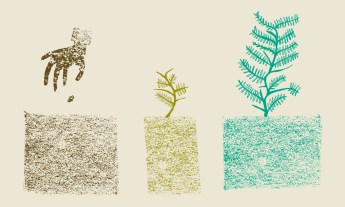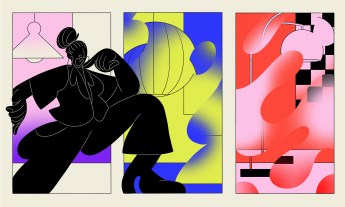
We all have important things we want to accomplish, but there are so many distractions and stumbling blocks that may get in our way. Here, writer Bina Venkataraman shares a startlingly easy strategy to use to defeat future challenges.
Playing poker is like planning for the future in one sense: You’re making decisions with limited information, and a lot depends on chance. You can control what you do with only the cards and chips you have; you can’t control what cards you or your opponents are dealt, or what the other players do. You make your choices amid uncertainty about how it will all pan out.
For the situations in our lives where we can anticipate what we might encounter — there are predictable obstacles that get in our way — the tricks of successful poker players can be illuminating. Matt Matros, a World Series of Poker champion who has earned more than $2 million, shared with me one of the rituals he credits for his success. When he first started playing, Matros loved the thrill of winning but because he also hated losing, he rarely won a tournament. He was too timid to play hands worth betting on. Trying to avoid momentary loss dimmed his long-run prospects — similar to how some investors lose their cool when they see dips in their stocks.
Matros, who earned a degree in math in college, became a poker champion only after coming up with a nerdy strategy. He decided he would aim for a certain ratio of bluffs to “value bets”— bets when he actually had a good hand — in a given game. When he didn’t have a good hand, he would fold a certain percentage of the time and he’d bluff the other times.
The strategy required that Matros anticipate the scenarios he might face, so he had a plan for how to react regardless of his passing fears of losing a hand. Because this was poker, he could calculate the chances of winning or losing he’d have with different combinations of cards, something that’s not so easy in life. Whenever he was in an intense moment and the exact card pattern was not one he had already anticipated, he’d think through his options. It was as if he had rehearsed the scene of a play and could think back to his scripted lines, with some improvisation.
Hundreds of studies — from eating better to avoiding the impulse to react to people on the basis of their skin color — have demonstrated the power of taking the time to anticipate in advance our future obstacles.
I wondered if Matros’s techniques could work for non-poker players, and I came upon the work of Peter Gollwitzer, a professor of experimental psychology at New York University. In the 1980s, Gollwitzer began studying how people can adhere to their long-term goals amid temptations. He found that most people were not lacking motivation to set such goals; the trouble came when they tried to keep on course when confronted with detrimental short-term urges.
Gollwitzer started testing a technique that resembles Matros’s strategy, which he dubs “implementation intentions,” or if/ then tactics. In hundreds of studies in all kinds of contexts — from eating better to completing homework assignments to saving money to avoiding the impulse to react to people on the basis of their skin color — Gollwitzer and colleagues have demonstrated the power of taking the time to anticipate in advance their obstacles when meeting future aspirations. For example, people who want to eat healthier would jot down all the possible temptations they’ll face in a week to eat junk food, and set up a plan to respond to each urge.
What’s surprising about Gollwitzer’s research on if/ then techniques is that it reveals that the more difficult the long-term goal, the greater the power of the tactic. In other words, it works better for the challenges that elude people’s sheer willpower. He’s also found that for groups of people who have the most difficulty with patience, perseverance and impulse control, the tactic works even better. When guided to use if/then tactics, schizophrenics, alcoholics and children with attention-deficit/ hyperactivity disorder resisted distractions and temptations and deferred gratification at high rates in his studies. They got more out of the tactics than those considered normal.
The more concrete your actions, the better the if/then ritual works. Focusing on positive actions — stating what you will do vs. what you won’t do — is particularly powerful.
Here’s how an if/then ritual can work in your life. Suppose you’ve decided you don’t want to check your email tomorrow morning so you can work on a project. To prevent yourself from succumbing, think through situations that might arise and come up with ways to respond. For example, you might decide: “If I realize I need to respond to an email, I’ll jot down a reminder in a notebook so I don’t forget to send it later.” Or: “If I feel tempted to check my email because I hit a hard spot in my project, I’ll get up from my computer and take a short walk instead.” The more concrete your actions, the better the if/then ritual works. Focusing on positive actions — stating what you will do vs. what you won’t do — is particularly powerful.
If/then rituals ask you to envision yourself taking a desired action in the future, not just to anticipate future scenarios. This struck me as a way of addressing the anxiety that some of us experience when imagining the future. With an if/then tactic, we can picture themselves with agency in a scenario. It’s a way of turning dread into a plan — and guiding our future vulnerable selves in a calmer present moment. When people make and state their specific plans to vote on Election Day, for example, they are far more likely to show up at the polls.
If/ then rituals seem fairly simple, even obvious. In fact, I hesitated to write about them, until I learned about more about their surprising, untapped potential. What intrigues me most about them is how they might be used to stop reckless decisions that could affect not just our own lives but the lives of others.
In 2009, Gollwitzer and colleague Saaid Mendoza made a stunning discovery through experiments in which they asked people to play a computer game. In the game, a series of images of men appeared, some holding objects and some holding guns. The objective is to shoot the men who appeared with guns and not shoot those who held other objects such as wallets or phones. (The choice involved pressing a labeled key that read either “Shoot” or “Don’t Shoot.”) Players were asked to work fast and make decisions in the moment. They had half a second before their time was up for each of 80 images.
The game showed images of both black men and white men. Previous studies had shown that players shoot the black men who are unarmed at far higher rates and more quickly than they shoot unarmed white men. They’re also more likely to not shoot armed white men than armed blacks.
When first given the game to play, the 2009 study’s participants — none of whom was black — exhibited this same pattern of what’s known as “implicit bias” or “unconscious bias.” In most cases, people who show these tendencies are not people who’d consider themselves racist or who’d consciously mistreat others because of gender, race, age or appearance. But in situations where they must act quickly, hidden biases can often dictate their actions and override their intentions.
Mendoza and Gollwitzer gave half the study participants an if/then tactic before they played the game. They were warned not to let other characteristics of the target — aside from what they were carrying — dictate their response. Researchers recommended people to follow this strategy: “If I see a person, I will ignore his race!” Participants were asked to repeat this strategy in their minds three times, and then type it into a box. Those who used the strategy had far fewer mistakes; they shot more armed people of both races and let the unarmed go free.
After if/then rituals were adopted in one public school, the skewed disciplining of black students dropped significantly. Overall, fewer students were sent to the principal’s office.
Educators are starting to take up this research. Kathleen Ellwood, a public school principal in Portland, Oregon, discovered in 2012 that in her K– 8 school, nearly 90 percent of the students being sent to the principal’s office were black — even though they made up only 15 percent of the student body.
National trends echo that pattern. In 2018, the US Government Accountability Office analyzed data from K–12 public schools and found black students were suspended and expelled at far higher rates than white students regardless of a school’s poverty level and the type of discipline. When teachers discipline students of color — and particularly young black children, studies show — they do so more harshly than they discipline white students for the same behaviors. As a result, more students of color miss valuable time in the classroom. This affects their achievement in school and in life, and kids who miss school are much more likely to land in the criminal justice system.
University of Oregon professors Kent McIntosh and Erik Girvan call these moments of discipline in schools “vulnerable decision points.” They’ve tracked discipline incidents and analyzed the data to show that such moments are often predictable. When teachers are fatigued at the end of the day or week or hungry after skipping lunch, they’re more likely to make rash decisions. Some moments are more specific to a classroom or teacher, but many can still be anticipated — for example, a kid with whom a teacher had a power struggle talks back in class.
McIntosh has trained hundreds of teachers to use if/then tactics, and Ellwood invited him to work with teachers in her school. He asked teachers to make an advanced plan for how they’d respond in a future moment when they’d be tempted to issue harsh discipline — and to state their plan clearly and concretely, aloud and on paper. The idea was to create an impulse buffer: a delay between the moment of frustration and the decision to discipline.
Let’s suppose a teacher recognized that she got frustrated on days she skipped lunch, especially when kids interrupted her as she was speaking. She’d make an advanced if/then plan and state it aloud as follows: “If a student speaks out of turn, then I will drop a pencil and take a deep breath before deciding what to do.” Or, she might say: “If a certain student acts up, then I will take three steps back with my hands behind me.”
After if/ then rituals were adopted, the skewed disciplining of black students dropped significantly in Elwood’s school. Overall, fewer students were sent to the principal’s office. McIntosh and Girvan are studying such tactics across multiple schools in the US to see if they consistently reduce discrepancies in discipline. Although the work is promising, it remains to be proven whether if/then strategies work across schools and classrooms. Still, simple rituals like these show that we each have the potential to help us be our best selves in the future.
Excerpted with permission from the book The Optimist’s Telescope: Thinking Ahead in a Reckless Age by Bina Venkataraman. Published by arrangement with Riverhead Books, an imprint of Penguin Publishing Group, a division of Penguin Random House LLC. Copyright © 2019 by Bina Venkataraman.
Watch Bina Venkataraman’s TED Talk now:

















